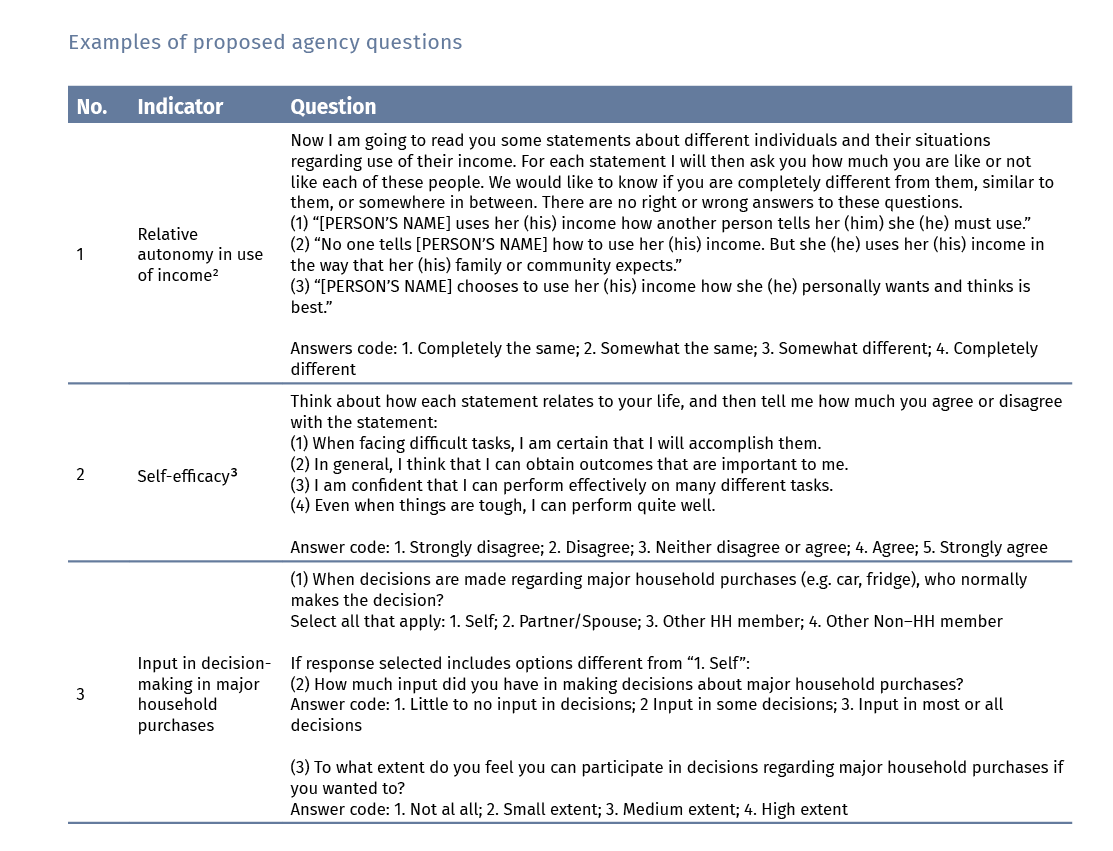
Search
Voice and Agency in the Measurement of Poverty

Back in 2007, Sabina Alkire identified ‘agency and empowerment’ as one of the “‘missing dimensions” of poverty data – dimensions that are of value to poor people, but for which we have scant or no data’. More than a decade later, and despite the expansion of multidimensional poverty measures and of the literature on agency and empowerment, this dimension remains largely ‘missing’ from measures of multidimensional poverty. One of the reasons for this is the lack of comparable indicators that can be measured using a simple and small set of questions.
Of the 42 Multidimensional Poverty Indices reviewed for this article, including official national MPIs and child MPIs, only 6 measures include indicators somewhat related to agency and voice.
However, they may not be strong indicators of the phenomenon they claim to capture. This shows that there is a demand for indicators of empowerment in middle-income countries.
This article briefly reviews and analyses the indicators and survey questions commonly used to measure individuals’ voice and agency in the development field and proposes a small set of questions to include in a multidimensional poverty survey questionnaire. This review leaves out scales and measures proposed in the psychological literature that have never been implemented in large scale household surveys.
Measuring agency in large scale household surveys
In the absence of an agreed-upon simple measure of agency, a set of indicators have been implemented and validated in the field of development. The most common are:
• Input in decision making: These are probably the most widely used and tested indicators of agency. They have been fielded by Demographic Health Surveys in many countries in past decades. One needs to keep in mind that these questions generally focus on household decisions, which makes them less suitable for households where there is only one potential decision-maker.
• Locus of control, self-efficacy and sense of agency: These are different measures of individuals’ perceived sense of control and ability to achieve goals. Conceptually, locus of control focuses on the relationship between means and ends, self-efficacy focuses on the relationship between agent and means, and sense of agency refers to the agent-ends relationship. Self–efficacy, seems to capture an individual’s capability more directly, is recognised as an important factor for behavioural change and does not require too many questions.
• Relative Autonomy Index: The Relative Autonomy Index (RAI) tries to measure the extent to which an individual’s behaviour in a specific domain is driven by the individual’s own values (’intrinsic motivation’) or by internalised social pressure or coercion (‘external motivation’).
• Attitudes towards intimate partner violence: The indicator measures attitudes towards intimate partner violence, which reflects the level of internalisation of the acceptability of this type of violence. This indicator is included in the DHS questionnaires as one indicator of female empowerment.
• Mobility: This indicator encapsulates freedom of movement. It is an indicator that probably makes more sense in contexts where freedom of movement might be restricted. Thus, this indicator is not suitable for inclusion in an internationally comparable poverty measure.
• Group membership, voting and volunteering: These can be seen as indicators of collective agency and voice. Participating in groups and engaging with peers is crucial for individuals as social and political beings, as it fosters a sense of belonging and empowerment. Unfortunately, the current formulation of the indicator for group membership (a series of ‘yes/no’ questions about specific types of groups) is too long to be included in a multidimensional poverty survey questionnaire.
• Speaking in public: As speaking in public is not an essential capability, this indicator is not a good candidate for inclusion in a multidimensional poverty survey questionnaire.
Proposed Indicators
All indicators were compared with respect to five criteria:
• Number of questions: Indicators that involve a higher number of questions impose a greater burden on respondents and survey providers.
• Whether the indicator is generalised or domain-specific: Domain-specific indicators require the repetition of the same set of question across the domains to be measured, leading to a higher number of questions.
• Extent of validation: Indicators that have been extensively validated are more likely to be reliable and accurate.
• Universal relevance: Distinguishes indicators that are relevant across the globe from indicators that are more relevant in specific contexts.
• Poverty-relevant deprivation: If it captures essential capabilities associated with poverty from other less essential capabilities.
Based on this comparison, it is concluded that the agency indicators most suitable for inclusion in a multidimensional poverty questionnaire are input in decision-making, self-efficacy, the Relative Autonomy Index, and attitudes towards intimate partner violence.

Who answers the questions and what decision-making do we measure?
It is also important to consider other aspects such as who should be eligible to answer the agency questions and what domains of decision-making should be included.
Ideally, the agency questionnaire module would apply to all adult household members, but that can be impractical and very expensive. Therefore, it is important to define who in the household should be eligible to answer the agency questions. One possibility is to target at least the two primary decision makers of the household.
The number of decision-making domains to consider should be relatively small, probably between one and three. They should also ideally be relevant for most individuals regardless of their age, sex, and marital status, such as decisions about allocation of monetary resources and time. Ultimately, this is a normative decision, so other domains could be selected based on different arguments.
Finally, further research is needed to test and validate agency indicators among individuals older than 50, as well as the measurement of these indicators in new domains of decision making.
1 The author is grateful for the feedback received from Agnes Quisumbing and Sunita Kishor during the Expert Workshop: ‘Improving the Collection and Availability of Multidimensional Poverty and Wellbeing Data’. All errors remain our own.
2 Example from the 2016 updated Women’s Empowerment in Agriculture Survey Index (WEAI) questionnaire.
3 Example from Project WEAI (Pro–WEAI) questionnaire.
This article was published in Dimensions 16
















